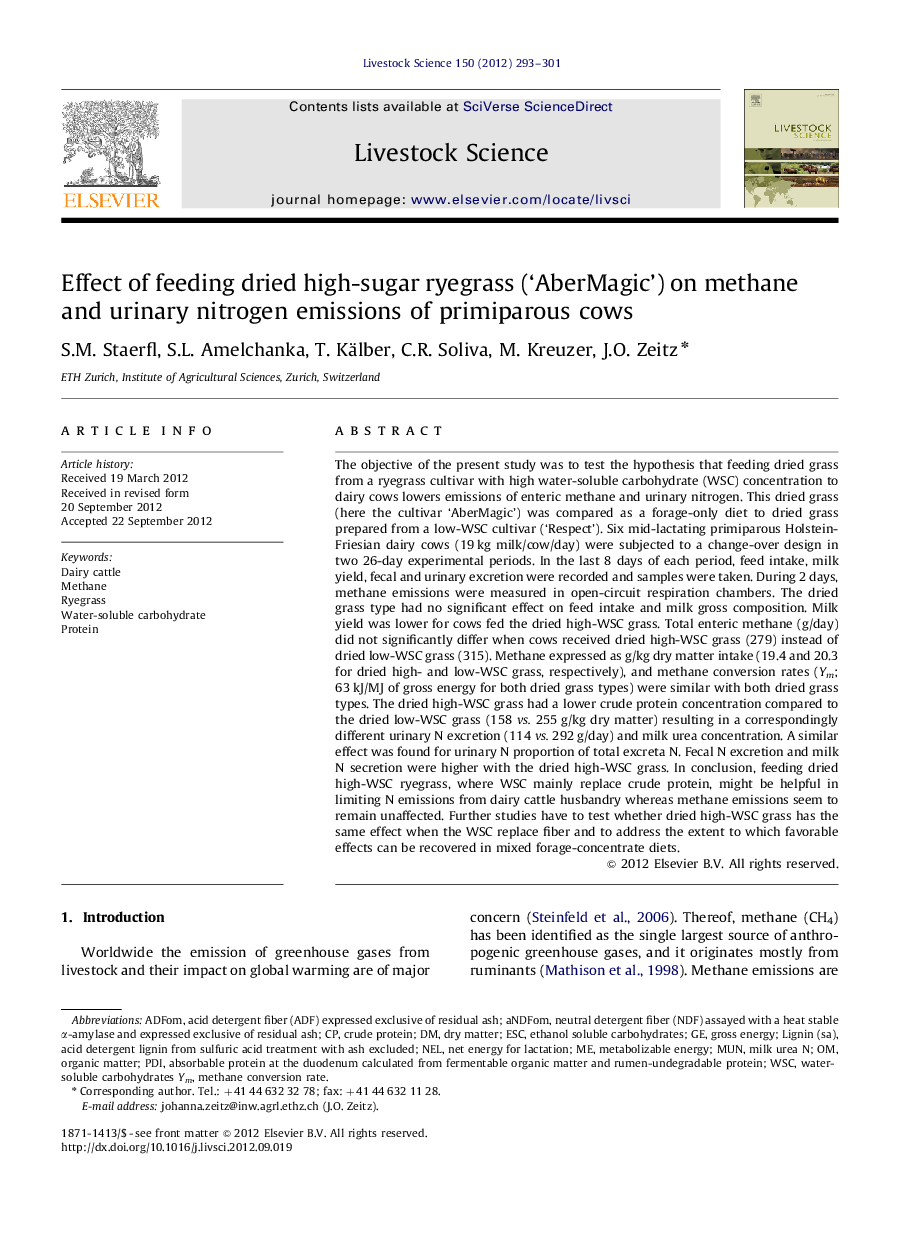| کد مقاله | کد نشریه | سال انتشار | مقاله انگلیسی | نسخه تمام متن |
|---|---|---|---|---|
| 5790502 | 1553982 | 2012 | 9 صفحه PDF | دانلود رایگان |
عنوان انگلیسی مقاله ISI
Effect of feeding dried high-sugar ryegrass ('AberMagic') on methane and urinary nitrogen emissions of primiparous cows
دانلود مقاله + سفارش ترجمه
دانلود مقاله ISI انگلیسی
رایگان برای ایرانیان
کلمات کلیدی
PDIADFomMUNaNDFomRyegrassnet energy for lactation - انرژی خالص برای شیردهیMetabolizable energy - انرژی متابولیزه شدهgross energy - انرژی ناخالصmilk urea N - اوره شیر NESC - خروجNEL - درLignin (sa) - لیگنین (در)organic matter - ماده آلیdry matter - ماده خشکMethane - متان Protein - پروتئینcrude protein - پروتئین خامWater-soluble carbohydrate - کربوهیدرات محلول در آبDairy cattle - گاو شیری
موضوعات مرتبط
علوم زیستی و بیوفناوری
علوم کشاورزی و بیولوژیک
علوم دامی و جانورشناسی
پیش نمایش صفحه اول مقاله

چکیده انگلیسی
The objective of the present study was to test the hypothesis that feeding dried grass from a ryegrass cultivar with high water-soluble carbohydrate (WSC) concentration to dairy cows lowers emissions of enteric methane and urinary nitrogen. This dried grass (here the cultivar 'AberMagic') was compared as a forage-only diet to dried grass prepared from a low-WSC cultivar ('Respect'). Six mid-lactating primiparous Holstein-Friesian dairy cows (19Â kg milk/cow/day) were subjected to a change-over design in two 26-day experimental periods. In the last 8 days of each period, feed intake, milk yield, fecal and urinary excretion were recorded and samples were taken. During 2 days, methane emissions were measured in open-circuit respiration chambers. The dried grass type had no significant effect on feed intake and milk gross composition. Milk yield was lower for cows fed the dried high-WSC grass. Total enteric methane (g/day) did not significantly differ when cows received dried high-WSC grass (279) instead of dried low-WSC grass (315). Methane expressed as g/kg dry matter intake (19.4 and 20.3 for dried high- and low-WSC grass, respectively), and methane conversion rates (Ym; 63Â kJ/MJ of gross energy for both dried grass types) were similar with both dried grass types. The dried high-WSC grass had a lower crude protein concentration compared to the dried low-WSC grass (158 vs. 255Â g/kg dry matter) resulting in a correspondingly different urinary N excretion (114 vs. 292Â g/day) and milk urea concentration. A similar effect was found for urinary N proportion of total excreta N. Fecal N excretion and milk N secretion were higher with the dried high-WSC grass. In conclusion, feeding dried high-WSC ryegrass, where WSC mainly replace crude protein, might be helpful in limiting N emissions from dairy cattle husbandry whereas methane emissions seem to remain unaffected. Further studies have to test whether dried high-WSC grass has the same effect when the WSC replace fiber and to address the extent to which favorable effects can be recovered in mixed forage-concentrate diets.
ناشر
Database: Elsevier - ScienceDirect (ساینس دایرکت)
Journal: Livestock Science - Volume 150, Issues 1â3, December 2012, Pages 293-301
Journal: Livestock Science - Volume 150, Issues 1â3, December 2012, Pages 293-301
نویسندگان
S.M. Staerfl, S.L. Amelchanka, T. Kälber, C.R. Soliva, M. Kreuzer, J.O. Zeitz,